
MAY CONTAIN NUTS

Search Shorpy
SHORPY ART

Framed or unframed, desk size to sofa size, printed by us in Arizona and Alabama since 2007. Explore now.
Join and Share
Ad-Free Shorpy
Shorpy is funded by you. Patreon contributors get an ad-free experience.
Learn more.

Recent comments
- Freeze Frame
- Texas Flyer wanted
- Just a Year Too Soon
- WWII -- Replacing men with women at the railroad crossing.
- Yes, Icing
- You kids drive me nuts!
- NOT An Easy Job
- I wonder
- Just add window boxes
- Icing Platform?
- Indiana Harbor Belt abides
- Freezing haze
- Corrections (for those who care)
- C&NW at Nelson
- Fallen Flags
- A dangerous job made worse
- Water Stop
- Passenger trains have right of way over freights?
- Coal
- Never ceases to amaze me.
- Still chuggin' (in model form)
- Great shot
- Westerly Breeze
- For the men, a trapeze
- Tickled
- Sense of loneliness ...
- 2 cents
- Charm City
- What an Outrage
- Brighton Park
Member Photos
The Shorpy
Print Emporium
Print Emporium
Search Shorpy
Search results -- 30 results per page
- Yesterday in the Park: 1907
- Chicago circa 1907. "Jackson Park -- Driveway and Field Museum." Formerly the ... a smelly nuisance.
(Panoramas, Cars, Trucks, Buses, Chicago, Dogs, DPC) ... Posted by Dave - 01/19/2024 - 4:46pm -
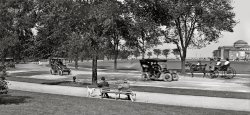
- Noel, Iola: 1944
- ... PREPAREDNESS
CHICAGO (Dec. 23, 1944) -- Mrs. Iola Swinnerton Warren, who suffered the ... - I found the announcement from the Suburbanite Economist (Chicago) of December 23, 1942. It sounds like she had a terrible time with this ... Posted by Dave - 12/24/2023 - 11:31am -
![Noel, Iola: 1944 On this Christmas Eve, we travel back 79 years for a visit with the First Lady of Shorpy, Iola Swinnerton. Some two decades after her bathing-pageant days, she is still radiating beauty and cheer. Scroll down to the comments for more of Iola's life story. View full size.
"STONE WOMAN" ENJOYS
CHRISTMAS PREPAREDNESS
CHICAGO (Dec. 23, 1944) -- Mrs. Iola Swinnerton Warren, who suffered the illness known as myositis ossificans after inoculation for typhoid following a Florida hurricane, watches her husband Theron V. Warren and little nephew Herbert Taylor trim Christmas tree. (Acme Newspictures photo.)
Licensed to Marry.From the Washington Post of August 4, 1918:
"Gerald Swinnerton, 31, of Williamston, Michigan, and Iola Taylor, 18, of Rockford, Illinois."
Iola in 1947Here is part of article from the Waterloo Sunday Courier (Waterloo, Iowa) of March 9, 1947. The Warrens adopted Herbert Taylor (Iola's nephew). Herbert was 13 in 1947.
Forever YoungIt would seem, from an earlier comment, that she was born in 1902, so she would have been 19 or 20 in those earlier photos from 1921 and 1922, and 42 here. She has lovely, youthful skin and a radiant smile.
[If she was 18 when married in 1918, she'd have been born in 1899 or 1900. - Dave]
Not just Christmas celebrationsThis is also the occasion of their second wedding anniversary - I found the announcement from the Suburbanite Economist (Chicago) of December 23, 1942. It sounds like she had a terrible time with this illness -- it started in 1926 and she spent nine years in the hospital! I'm glad she seems to have found happiness with Theron.
Based on what I read about myositis ossificans, it seems unlikely that this is what she had. It is normally caused by an injury to a muscle, and from what I can tell, stays within that muscle -- it doesn't spread to other areas of the body. It's probably more likely that she had heterotopic ossification, possibly caused by central nervous system injury or an underlying genetic disorder.
*Cringe*I am sure that Herbie really enjoyed being characterized in the newspaper as her "little" nephew.
Hope his friends didn't see the story!
[He looks like Larry Mondello. - Dave]
Carpentry and TweedNotice the nicely done rest for her feet that does not appear to be part of the original wheelchair--not the easiest thing to put together if you're doing it with nails instead of wood screws, which may be the case here. Also, I love the nephew's tweed slacks--sadly, winter weight slacks seem to be a thing of the past, even up north here in Minnesota. They're keeping him so warm, he doesn't need to keep his shirt tucked in.
The story that keeps on givingAnother amazing feature of this website. Over the course of eleven and a half years (dating back to April of 2007) we are treated to a series of photos of Iola Swinnerton from a very specific two-year period (1921-1922) in a very specific context (bathing suit beauty contest). No sense of limitation or lack of variety, and every new photo was a delight.
Flash forward suddenly 22 years to 1944 and to a whole new context. We find Iola in a wheelchair with a strange and rare disease, and yet she is happy, recently married to a benevolent-looking church organist, and she and her husband have adopted her nephew. The husband "wasn’t discouraged because the pretty invalid was confined to a wheelchair," and she is able to report that her "condition has steadily improved" since they got married.
The crowning glory of her positivity: "My dreams during so many years in hospitals have come true." (She writes songs which are published!) "I only hope someone else can take hope from my happiness." This is one of the most truly marvelous stories I've ever come across.
Stiff Man’s SyndromeIola may have had what is now called Stiff Person’s Syndrome. It was first diagnosed in 1956.
A friend had it.
IolatryHere's a few more details regarding Iola.
The New York Times, while reporting her wedding, stated that she was earning her living as a seamstress. The paper also said, "She was stricken by the baffling disease after the Florida Hurricane of 1926. At that time she lived in a Miami Beach cottage, the wife of Gerald Swinnerton, whom she divorced in April, charging desertion."
In the 1940 U.S. Census Gerald Swinnerton is claiming to have been widowed. He was a camera designer and repairman, as well as a World War I veteran, and he was also known as George Simons. He died in 1961.
Regarding her wedding, the Chicago Tribune of December 24, 1942 published the following story.
"Smiling from her wheelchair, in a moire taffeta wedding dress and a shoulder length tulle veil, Iona Swinnerton, 40 years old, was married last night to Theron Victor Warren, 42, a shipyard worker and organist in the Wentworth Baptist church. The bride is suffering from a rare disease characterized by hardening of the muscles.
"About 100 relatives and friends were present as the Rev. Eugene H. Daniels read the marriage ceremony. L. Duke Taylor, 1918 Cleveland avenue, her brother, gave the bride away. Donald McGowan, 1954 Henderson street, was the best man.
"Miss Swinnerton, who lives at 4044 Wentworth avenue, has been suffering from the malady since 1926. She teaches a Bible class at the church, and met Warren while attending the services there."
An article in the Cedar Rapids Gazette in December 1945 indicated that she had spent six years at the Cook County Hospital for treatment of her condition. She was refinishing furniture and canning fruit in addition to writing songs. "Theron proposed not very long after I cooked him a duck dinner," she confided.
In 1949 Iola won fourth place in a nationwide Army songwriting contest, which earned her a $50 savings bond. The title of the tune was "Three Cheers For the Army." She died five years later, in 1954. Her obituary from the Chicago Tribune is below.
"Iola N. Warren, 2642 Barry avenue, June 13, 1954, beloved wife of Theron V. Warren, dear sister of Louis Duke Taylor, dear aunt to Herbert Taylor. At chapel, 316 W. 63d street, at Harvard avenue, where services will be held Thursday, June 17, at 1 p.m. Cremation Oak Woods."
Theron Warren died on May 3, 1976.
The image below is from the January 4, 1937 issue of the Wilson (N.C.) Daily Times.
FOPI presume Iola had fibrodysplasia ossificans progressiva.
Story of Two FamiliesLuckily, I accepted an invitation to the Swinnertons' Christmas party before the invitation to the Dickeys' Christmas party arrived.
Three cheers for King CottonThe pants of the kid look as if they are scratchy. Ask me how I know.
It’s a small worldI’ve been a long-time Shorpy lurker, and have many of the wonderful images saved as desktop wallpaper.
I had to comment on this picture -- the Eugene H. Daniels mentioned as the officiant in the newspaper article was my great-grandfather! By the time I knew him, he was just “Grandpa Dan”; it’s neat to be able to read about Iola and Theron some 78 years later.
Merry Christmas to all!
Eeugh!Theron is a ringer for an ex of mine. I hope Iola had better luck--she certainly endured enough as it was.
(The Gallery, Chicago, Christmas, Iola S., Kids, News Photo Archive)](https://www.shorpy.com/files/images/SHORPY-1368.thumbnail.jpg)
- Chicago: 1943
- Chicago, April 1943. "New York Central diesel switch engine moving freight cars ... be too many railroad or automobile pictures on Shorpy!
Chicago north of the river That little brown building to the left is still ... be done. Just no train.
(The Gallery, Kodachromes, Chicago, Jack Delano, Railroads) ... Posted by Dave - 08/10/2012 - 8:36pm -
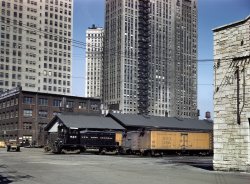
- Chicago: 1920s
- ... North Clark in the Rogers Park neighborhood of northeast Chicago (Thanks TD for figuring that out). View full size.
Gasoline ... and then later in the country, this is the type of Chicago neighborhood that inspired Frank O. King when he created the ...
View Larger Map
Union Pacific (ex- Chicago & North Western) For true-blue Chicagoans, the three Union ... Posted by globalpillage - 09/14/2011 - 6:23pm -
![Chicago: 1920s Taken from the old elevated Union Pacific/North Line track looking due east up West Arthur Avenue toward North Clark in the Rogers Park neighborhood of northeast Chicago (Thanks TD for figuring that out). View full size.
Gasoline AlleyAlthough he lived in an apartment on the Southside and then later in the country, this is the type of Chicago neighborhood that inspired Frank O. King when he created the long-running (1918 to date) "Gasoline Alley" comic strip. The homes he depicted were built before the automobile was prevalent and so did not have garages. If you owned your own home you could have added a garage with an alley entrance at the back of the property just as Noelani suggested. If you rented rather than owned, you could rent a garage from entrepreneurs who built them in the alleys behind their commercial property. These rows of garages were called Gasoline Alleys. Sometimes these rented garages were blocks away from where the car owner lived. Often, if you took public transportation to work, you would visit your car in its rented garage only on the weekends. Since there were many others renting in your alley that were not from your neighborhood, the garage communities were like a second home neighborhood for the weekend and days off, creating another whole set of friends.
The still running Gasoline Alley strip had the distinction of being the first comic in which the characters aged in real time, with babies being born and growing up and old folks dying. The panel below, which shows the main character Walt coming home to a house much like those in the picture above, is from the May 25, 1921 comic strip.
About the AuthorThis is our first post from Pete Mauney, proprietor of Global Pillage. More about his collection here.
Still there, bigger treesView Larger Map
A bit olderLooking at the cars and the ad for Schaeffer beer, I would say this is the 1910's. Just my 2 cents.
[Schaeffer is a storage warehouse, not a beer. Also consider the format. This was imaged from a film negative, not a glass plate. - Dave]
My Old HoodLived near here while going to graduate school at NU. I loved Rogers Park. Less expensive than most neighborhoods, but still pretty nice overall. Most diverse hood in the city for many years, may still be.
After 91 YearsSame house, one way, new street lights and (probably) newer trees. Nice to see that, for the most part, the character of this quiet street has remained the same.
Rogers ParkThe steeple in the distance of the upper left (visible if the photo is enlarged) is that of St. Ignatius Catholic Church.
Welcome... to suburbia?
At least they put in decent sidewalks. In spite of the 1927 15 millionth Model T, carmania was still in check, or so it seems.
LOVE THIS SITEFeels like the best kind of time travel.
Siebold and Schaeffer StorageThe 1923 City Directory gives the location, 6542 N Clark St. The building is now the home of Burrows Moving and Storage.
View Larger Map
Union Pacific (ex- Chicago & North Western)For true-blue Chicagoans, the three Union Pacific commuter rail lines will always belong to the Chicago & North Western Railway, which was "absorbed" by the UPRR on October 1, 1995. Just as the elevated lines of the Chicago Transit Authority will always be known by their old route names, and not by their newer "color" names (Red Line, Blue Line, etc.) ...
Frozen in timeSeeing that little girl running enthusiastically toward the man sitting casually on the fence rail in the lower right of the photo highlights for me that it is truly like a frozen moment in time. Is that her mother walking fifty paces behind her with groceries?
NowadaysNot only have the trees gotten bigger, the Model Ts have morphed into Hondas and SUVs!
So few carsIs it a weekday and most of the cars are someone else, or did most people not yet have cars? Or, maybe there are alleys in the back of the houses where more of the cars are parked.
The treesUndoubtedly the best part for me is seeing how young the trees were. You were alble to see the entire block without much difficulty. Now, the old trees block much of the view.
William Wallen addition to Rogers ParkI live in Rogers Park, and have always loved this section of Arthur Avenue, as it's the closest thing Chicago has to a "bungalow court". The land these houses were built on (as well as that on which my own house was built) is called the William Wallen addition. The Chicago & Northwestern Railway purchased this land, which runs parallel to the tracks (now Metra), to build housing for railway employees. The first owner of my house was a CNW rail conductor! Wallen was an early settler of what later became Rogers Park, and he's honored by the naming of Wallen Avenue.
It Looks Like 1921I magnified the picture to 400% and looked at the car facing the camera. The logo on the radiator looks like the Chevy bowtie. From there I pulled out my Sixty Years of Chevrolet book and narrowed the car down to 1920 - 1922 based on fenders, radiator, body style, lights and other characteristics.
Illinois used a dash or dot separator between the digits (like 22-222 or 111-111) on a five or six digit plate between 1922 and 1937. Since this plate does not have a separator the license plate must be from before 1922.
Illinois license plates had black lettering on an orange background in 1920 and white lettering on a black background in 1921. This plate has white lettering.
Therefore, this appears to be a photograph from 1921.
I Grew Up HereI grew up on this street, in the house at 1773 Arthur. It's rightmost house that's shown in full, the one with three vertical windows on the second floor.
My father's family moved into the house shortly after this photo was taken - my dad was 11 at the time - and my grandfather added dormers on the second floor, to make a separate apartment in the house.
Just south of this street were the barns for the city street cars. One of my earliest memories is of watching the streetcars rattle down Ravenwood Avenue and pull into the barns. After the streetcars were replaced with buses in the late 1950s, the city parked garbage trucks and snowplows on the site; now, it's a large police station.
The street is largely unchanged from when this photo was taken. The houses were built around the time of WWI, and all at the same time: if you walk up the street, you'll see the same three designs repeated in sequence. The houses also had the usual flourishes of homes built back then, including stained glass windows and oak floors. The houses were unusual for Chicago, though, in that they were built of firebrick covered with stucco, instead of being faced with brick or limestone.
The saplings in the picture were elms. Over the years, they grew into lovely shade trees, forming a cathedral arch over the street. However, the Dutch elm disease killed them all, and they were cut down in the late 1960s. The trees now on the street are maples and locusts that were planted in the 1970s.
The area just west of where the photo was taken was all truck farms in the 1920s. Later, it was developed and became a flourishing Jewish neighborhood. Nowadays, the Jewish people have moved on and their place has been taken by Indian and Pakistani immigrants. If you like Indian food, the intersection of Devon and Western, a short walk from where this photo was taken, is *the* place to go in Chicago - it also has the only halal KFC I've seen anywhere.
Many thanks to the poster, for bringing back so many memories.
The Old NeighborhoodMy grandparents purchased a building two blocks east of the position of this photo back in the late 1930s at the intersection of Wallen Ave and Clark. Our entire family resided in a bungalow home much like those in the pic in the adjacent neighborhood a mile to the west (West Rogers Park/ Westridge)from the early 50s through the late 70s. This community was an extremely prosperous area during that time period anchored by the Devon Ave business corridor.
Great picture, great comments.I enjoyed taking long looks at this picture, and the great comments too. I grew up, in the seventies, on Sheridan and Glenlake. I was always jealous of kids who grew up in houses like these. I grew up in a highrise.
(ShorpyBlog, Member Gallery, GlobalPillage)](https://www.shorpy.com/files/images/IHP01_DV_perfect_street_small.thumbnail.jpg)
- I.C.R.R.: 1942
- November 1942. "Chicago, Illinois. Locomotives in the Illinois Central railyard." Medium format ... is an extraordinarily powerful image. A dreary November Chicago day and a bleak unknown future for our county all less than one year ... Delano scored a winner with this shot.
(The Gallery, Chicago, Jack Delano, Railroads) ... Posted by Dave - 01/16/2024 - 4:47pm -
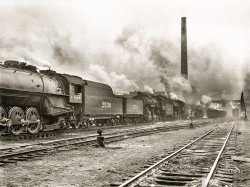
- Changing Chicago: 1910
- Chicago circa 1910. "Madison Street, Hotel Brevoort & La Salle Opera ... A bit hard to sort out the depth, but my resident Chicago expert (my wife!) thinks we are looking at the intersection with ... which still exists.
In March 2014, Preservation Chicago, an architectural preservation group that releases an annual list of ... Posted by Dave - 05/06/2023 - 3:01pm -
![Changing Chicago: 1910 Chicago circa 1910. "Madison Street, Hotel Brevoort & La Salle Opera House." The fad for automobiles seems to be growing. 8x10 inch glass negative. View full size.
Looking East Toward WabashA bit hard to sort out the depth, but my resident Chicago expert (my wife!) thinks we are looking at the intersection with Dearborn St., then State St., and beyond that the Wabash Ave. elevated station (part of the "Loop",) which still exists.
In March 2014, Preservation Chicago, an architectural preservation group that releases an annual list of Chicago's seven most endangered buildings, included the Madison/Wabash station on its 2014 list, noting that it is the last original "L" station house on the east leg of the Loop.
PreponderancesIn 1910 women were definitely the minority on the streets of any village, town, or city. They were at home nurturing their children, which is unfortunately not the case in 2014.
[You'd think they'd have grown up by now. - Dave]
40 more years......and it would be razed to make way for St. Peter's Church. Judging by the El track about a block away, it looks like the picture is of it at its 137 W. Madison address, so this would have been taken right before it moved across the street to 110 W. Madison the same year.
One Block Farther WestThe Hotel Brevoort was at 120 West Madison Street, between La Salle and Clark, so the photographer must be standing just east of La Salle Street, looking east on Madison as Dennis M. says. That would make Clark Street the first intersection we can see, followed by Dearborn, State, and Wabash. There are quite a few well known early skyscrapers clustered together in the foreshortened perspective at the far end of this view, including the Champlain Building (demolished 1916) on the left, and the Chicago Building, the Carson Pirie Scott Store, and the Heyworth Building (all still standing) on the right.
2 MetersThe first two cars on the left appear to be taxis, with their meters clearly visible.
(The Gallery, Cars, Trucks, Buses, Chicago, DPC, Streetcars)](https://www.shorpy.com/files/images/SHORPY-4a25226a.thumbnail.jpg)
- A Dickey Christmas: 1919
- ... the College of Journalism at Northwestern University in Chicago, where he was a member of the varsity swim team, and in his senior year ... 1928 he married La Verne Carnes and the couple settled in Chicago where Granville was an advertising manager for a large wholesale house. ... Posted by Dave - 12/20/2023 - 3:27pm -
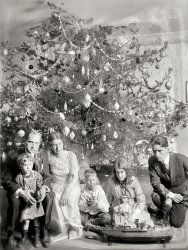
- PneuTube: 1942
- November 1942. "Chicago, Illinois. A pneumatic tube system connects the main yard office ... had cash registers with eight drawers. In 1972 I flew to Chicago from Seattle and my cash was sent off in a pneumatic tube.
Central ... his jacket and bow tie.
(Technology, The Gallery, Chicago, Jack Delano, Railroads, The Office) ... Posted by Dave - 01/05/2024 - 3:13pm -
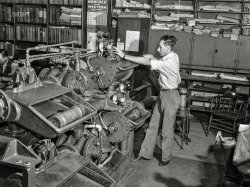
- Trackwork: 1942
- November 1942. "Chicago, Illinois. Maintenance crew repairing roundhouse tracks at an Illinois ... are four laborers and nine shovels.
(The Gallery, Chicago, Jack Delano, Railroads) ... Posted by Dave - 01/17/2024 - 2:55pm -
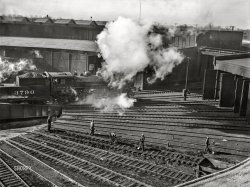
- Oil Train: 1942
- November 1942. "Chicago, Illinois. An oil train from the Southwest leaves an Illinois Central ... a thing Lengthy oil trains like this move through Chicago and Milwaukee today.
I have read that the boom in American & ... one passed as I was re-photographing a Shorpy scene, ( Chicago: 1956 ) it took 10 or 15 minutes to go by.
Oh no! Not Algebra! ... Posted by Dave - 01/09/2024 - 3:05pm -
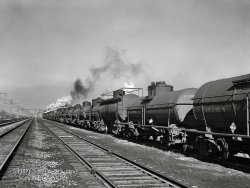
- Jackson Park: 1907
- Chicago circa 1907. "Lake Shore Drive, Jackson Park." 8x10 inch dry plate glass ... March 31, 1925.
(The Gallery, Cars, Trucks, Buses, Chicago, DPC) ... Posted by Dave - 01/19/2024 - 4:39pm -
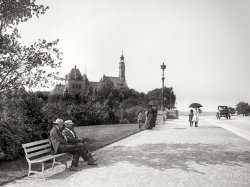
- Chicago: 1943, 11:35
- ... Street freight depot of the Illinois Central Railroad at Chicago. View full size. 4x5 Kodachrome transparency by Jack Delano.
... two blocks away, which would have been the tallest in Chicago if the Great Depression had not resulted in the project's cancellation. ... Posted by Dave - 08/10/2012 - 4:56pm -
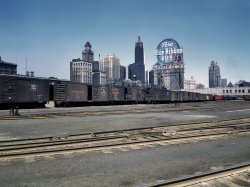
- Engine of Change: 1942
- November 1942. "Chicago, Illinois. In the roundhouse at an Illinois Central Railroad yard. This ... technology past and present.
(The Gallery, Chicago, Jack Delano, Railroads) ... Posted by Dave - 01/08/2024 - 7:29pm -
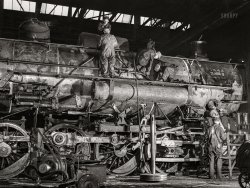
- The North Yard: 1942
- November 1942. "Chicago, Illinois. General view of the north classification yard at an Illinois ... (switch?) towers occupied, but no.
(The Gallery, Chicago, Jack Delano, Landscapes, Railroads) ... Posted by Dave - 01/11/2024 - 1:36pm -
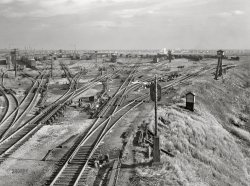
- Yardwork: 1942
- November 1942. "Chicago, Illinois. Tender and switch engine at an Illinois Central railyard." ... something bumped the camera. - Dave]
(The Gallery, Chicago, Jack Delano, Railroads) ... Posted by Dave - 01/09/2024 - 3:11pm -
![Yardwork: 1942 November 1942. "Chicago, Illinois. Tender and switch engine at an Illinois Central railyard." Acetate negative by Jack Delano for the Office of War Information. View full size.
FuzzyAt first I couldn't figure out if it was my glasses needed changing or a part of the photo was out of focus. Come to the conclusion probably both!
[It's in focus -- twice. Maybe something bumped the camera. - Dave]
(The Gallery, Chicago, Jack Delano, Railroads)](https://www.shorpy.com/files/images/SHORPY-8d09741u.thumbnail.jpg)
- Great Northern: 1900
- Chicago circa 1900. "Great Northern Hotel and office building, Dearborn and ... the next place would be a locksmith?
[The sign says Chicago Bronze. - Dave]
Lady barbers!? Women cutting men's hair, ... fire escape where the tall buildings join!
Nice! "Chicago School" architecture. It was designed by Daniel Burnham, who also did ... Posted by Dave - 06/14/2022 - 10:29am -
![Great Northern: 1900 Chicago circa 1900. "Great Northern Hotel and office building, Dearborn and Jackson Streets." Along with perhaps the earliest appearance on these pages of Coca-Cola signage. Also: a "Lady Barber Shop." 8x10 inch glass negative, Detroit Photographic Company. View full size.
Urban TotemsIf the colorful carved pole is in front of the barber shop and a perched spigot is at the entrance to the bath-house, I would think the next place would be a locksmith?
[The sign says Chicago Bronze. - Dave]
Lady barbers!?Women cutting men's hair, ladies smoking cigars, or Lady as a last name?
Unfortunately the Great Northern building was demolished. Also, there is no Google street view of this block (Dearborn and Jackson) for some reason.
Knot a typoIf you wore Ruppert's shoes then you "knew" the feeling of dry socks…I guess. Otherwise, big multiple typo! Elsewhere, great fire escape where the tall buildings join!
Nice!"Chicago School" architecture. It was designed by Daniel Burnham, who also did the Flatiron Building. It was demolished in 1940 and has since been replaced by the Dirksen Federal Building.
WowI can actually see the characters come to life from "Sister Carrie." One of my favorite novels from 1900.
What in the world ......does "Slaunch and true, thru and thru" mean? Besides "knew/new," "slaunch" struck me as odd. Possibly a word that's out of usage?
[The word is "staunch," not "slaunch." - Dave]
At the sign of the spigotI've seen plenty of giant eyeglasses outside opticians' offices on Shorpy, but never a spigot outside a bathhouse. What a great idea.
And a great picture--keep the Chicago pictures coming.
Someone doesn't wear Ruppert shoesAny idea who the guy in the drink in the Ruppert shoe sign would be?
[A lost sole. - Dave]
Did I miss it?Where's the milk bottle?
Tennis anyone?Is roof fenced off for athletics, possibly tennis on the building behind the Great Northern at the top far right?
Southern Serves the SouthBehind the Great Northern there is an office for the Southern Railway. My Pop was a designated Southern Railway railroad doctor, and when I was a kid I had a bright red billed cap that had the SR with the arrow logo as seen on here. It was my favorite cap. . . .
The railroad liked having doctors in the various towns through which its lines passed, so that local workers, if injured, had a local doc to go to. Incidentally, Dad is still a railroad doc, though for Norfolk Southern now. Southern merged with I guess the Norfolk and Western line about 1985 & was later renamed Norfolk Southern.
Ye Olde Old GloryWe can narrow the date range a little bit thanks to the American flag flapping on the left side of the photo. That flag design was used starting July 4, 1896, when Utah became a state.
Too bad JJ Astor IVdidn't wear a pair of Ruppert's Dry Sox on his 1912 crossing!
View from The MonadnockEvery building in this photo is gone. Although the photographer's vantage, Burnham & Root's 1893 Monadnock building, still stands.
Chicago Federal Centerhttp://www.panoramio.com/photo/1307733
I believe this building covers the entire block where the hotel stood.
Similar buildingsI am struck by the similarities between these buildings and the Old Colony (where I worked in the mid 1980s) and the Manhattan, which still stand in the block between Van Buren and Congress and Dearborn and Plymouth Court. The Old Colony has the round corners, but the windows are very different.
Cigars vs. CigarettesIt's hard to imagine now that long ago cigar smokers far outnumbered cigarette users, as evidenced by the many advertising signs in all these photos. When I was a kid in the 1960's the drug stores still had large glass-front humidor cases with open cigar boxes so you could purchase individual cigars, but this practice died out before the decade ended. Then we had to find another way to light our firecrackers.
Coke advert?Where is it in the pic? I can't find one.
Political unbuildingas noted below - way below - the hotel itself, and the Bedford Building at the far left of the picture (whose spectacular corner spire has unfortunately been cut off), were among a large number of buildings in Chi-town demolished around 1940. The Tribune tried to turn their demise into a partisan issue, illustrating their removal in a 02/17/40 article headlined "Some of the Chicago Buildings Wrecked During New Deal Depression," but it failed to note the reason for their demolition: construction of the Dearborn Street Subway (there was concern the digging would undermine their foundations).
Catarrh cureAs a longtime sufferer from catarrh--the name sounds both ridiculous and ominous--I am wondering how to get my hands on some of that Blue Gum Compound. Surely a more pleasant treatment than pseudoephedrine, phenylephrine, or guaifenesin.
In fact, blue gum honey (eucalyptus globulus) is sold today as a treatment for various effects of "phlegmatic deposition." Australian brands are widely available.
But alas, even 122 years later, there is no cure for catarrh.
The Gunning SystemGunning was a big player in the world of giant urban advertising billboards. The City of Chicago fought them tooth and nail: https://chicagology.com/advertising/chicagobillboards/
The photo appears to have been taken during the transition from "Every sign must begin with a capital letter and end with a period. Period." to "If there's no period, the letters can be a little larger"
[Mighty internal struggle to avoid using "period of transition" above.]
Eyes goin' badI'm gonna have to go and get a free eye exam at Sweet, Wallach & Co. People are gettin' kinda fuzzy.
Haven't we met somewhere before?I know -- it was at one of Gatsby's parties.
Whither Lady Barbers?I can't understand why this didn't catch on. I'd rather have my hair cut by a woman, but for most of my life, lady barbers were not an option.
Chicago School "bay window" style at its best.You can still see some around town.
Cable Car TrackChicago had a large cable car system that lasted until 1906. The far track had a centre slot for the grip to clamp onto the cable. Many of the lines turned downtown in loops, which may be the source of the term Loop in Chicago. More details here.
(The Gallery, Chicago, DPC, Railroads)](https://www.shorpy.com/files/images/SHORPY-4a08064a.thumbnail.jpg)
- Randolph Street: 1900
- ... September 1, 1900. "Randolph Street east from LaSalle, Chicago." 8x10 glass negative, Detroit Publishing Company. View full size. ... can't find a hatless noggin in sight.
Eternal Life in Chicago The Cook County Democratic Party saw to it that you voted even if ... Posted by Dave - 07/20/2012 - 3:42pm -
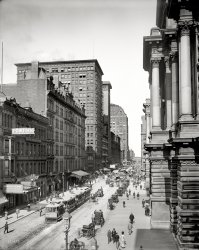
- High Voltage: 1942
- ... first to wire a head for a reservation.
We travel to Chicago now and then ... And our preferred stop is at the Best Western in ... Posted by Dave - 08/18/2023 - 3:24pm -
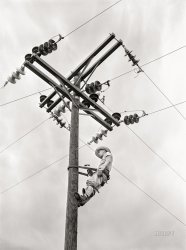
- Burlington Zephyr: 1939
- ... back!
Zephyresque Today's BNSF commuter trains in Chicago still use corrugated stainless steel coaches and recently have added ... up. Looks like a pig in a prom dress.
Denver to Chicago In 1934 in the depths of the depression an earlier version of this ... Posted by Dave - 09/10/2010 - 10:29am -
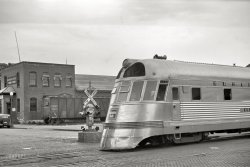
- Theatorium: 1907
- Chicago, 1907. "State Street south from Lake Street." At left, the Masonic ... across the street from the Theatorium is where the Chicago Theater stands.
Trolley Car Drafting Couldn't help noticing ... you eat, the more you want! - tterrace]
View from Chicago 1) Beautiful picture.
2) Happily, quite a bit of this real ... Posted by Dave - 07/19/2012 - 12:58pm -
![Theatorium: 1907 Chicago, 1907. "State Street south from Lake Street." At left, the Masonic Temple and Marshall Field department store. Photo by Hans Behm. View full size.
Gene Siskel Film Centeris not where the Theatorium is. That is where the local ABC-TV affiliate broadcasts. The Film Center is past that alleyway, right in the middle of that half-block. It would be directly across the street from the Masonic Temple. Speaking of theaters, across the street from the Theatorium is where the Chicago Theater stands.
Trolley Car Drafting Couldn't help noticing how the horse drawn wagons neatly fit onto the trolley tracks. Almost looks like they are 'drafting' the trolley cars. Early NASCAR training?
Don't Jump!Does the man washing the windows on the second floor work his way up, or has he worked his way down?
Odd Name..Up in the corner, by the "Shorpy" mark is the name Dr. McFatrick or McFatrich. It is difficult to make out the last letter of the name as it is partially obscured by the corner of the building.
Also, since it is 11 (eleven) floors up, can anyone at street level actually see that?
Oh I do like the Wells Bros. Sign ( Wells 20 Century Molasses Candy) I Just wish I could read the whole thing.
[The more you eat, the more you want! - tterrace]
View from Chicago1) Beautiful picture.
2) Happily, quite a bit of this real estate is still standing--Marshall Field's (third building on the left); Carson Pirie Scott (fifth on the left); Reliance Building (the white building of which a sliver is visible on the right side of the street)
3) This photo shows what a tragedy it was that they tore down the Masonic Temple--second building on the left--in 1939 to build a two-story "taxpayer."
4) Interestingly, today the site of the Theatorium is the Gene Siskel Film Center, the cinematheque of the Art Institute of Chicago. I like the sound of "Gene Siskel Theatorium" much better.
5) How this scene looked as a tinted postcard:
Upper left side of pictureI wonder if Dr. McFatrick was a weight loss specialist. I am also thankful that I don't have that last name as I surely would have been the butt of jokes from the time I was born.
When in doubt- -use Latin in your signage, also what is LUNGH ? ?
[It's what you have when you're hunchry. - tterrace]
The old slotElectric trolley (tram) cars replaced the Chicago City Railway cable cars on the left hand track a year age, but the slot to reach the underground cable remains.
Ornamental Street LightThere have been many interesting street lights in Shorpy city views, but this one of an arc light is one of the best. A number of cities have replicated original standards, albeit with modern light sources. Metal halide and LED light sources are similar to arc lights, and a vast improvement over orange sodium vapour.
Re: the first commentActually Fitz a commenter on a previous pic many weeks ago implied that streetcar guages were predicated on the standard width of the wagon wheels, supposedly. And from that, many other things were extrapolated. The story has its detractors and originally actually corresponds to chariots and the standard 4'8" railroad track but you get the idea. What is known is that even if the width is coincident or seredipitous, wagon drivers liked to travel in the streetcar ruts for obvious reasons. The internet "lore" can be found at: http://www.naciente.com/essay94.htm
Aching tooth?This is the place to fix that problem. I spy at least 3 separate dentist offices (including McFatrick).
Big PerkBarely visable on the right, above the sign that says "lunch", is an overgrown coffee pot. I just love these giant sign tokens. I've seen molars, eyes and glasses, mortars and pestles, hats, hands, etc, etc. As someone wondered in a previous post, what happened to these and do any still exist? As an ex-antique store owner I would love to start a collection, but I know I would first have to win the gazillion dollar lottery.
Chicago 2012 State Street south from Lake StreetFor this photo, the 1907 photographer and I both stood on the elevated "L" train platform which was built in the 1890s.
Some of the old (to us) features of State street don't yet exist in the 1907 photo.
The Chicago Theatre dates from 1921. The subway entrances in the foreground lead to the 1943 subway.
(The Gallery, Chicago, DPC, Stores & Markets, Streetcars)](https://www.shorpy.com/files/images/SHORPY_4a22369a.thumbnail.jpg)
- Public Square: 1900
- ... to see some architectural drawings of that facade.
Chicago Milwaukee & St. Paul Soon to become The Milwaukee Road, with ... Cleveland, at least not directly. They all went from Chicago westward. So their offices in Cleveland must have been for exchange of ... Posted by Dave - 04/07/2023 - 11:19am -
![Public Square: 1900 Circa 1900. "City Square. Soldiers' and Sailors' Monument, Cleveland." 8x10 inch dry plate glass negative, Detroit Photographic Company. View full size.
The May Co. BuildingWow, looks like the predecessor of the modern curtain-wall design. Large lights of 1/4" plate glass no doubt. Would love to see some architectural drawings of that facade.
Chicago Milwaukee & St. Paul Soon to become The Milwaukee Road, with Hiawatha service to almost anywhere. Brook Stevens who designed their rail cars would have (maybe did) marveled at the May Co. building of the future.
I'm marveling at in this picture. Probably 50 years before its time.
No rebellious women?One would think there would have been at least one daring young woman who would have had the gumption to wear a black blouse with a light colored skirt, just to be a little outrageous and stand out, but nooooo. Times sure have changed in the area of seeking attention through outrageous fashion and personal appearance. Or maybe today's girls just feel more comfortable expressing themselves, which certainly does make street scenes more interesting.
Where's the Cable Car?http://www.cable-car-guy.com/html/ccohio.html#cccr
According to the above link, the cable car slots under the trolley car were used for another year until 1901, even thought the St. Clair trolley car in the foreground had directly replaced the horsecars on its line in 1893.
Western RailroadsTerryN, thanks for pointing out the CM&StP sign in the window. The same building also has signs for the Burlington Route and Rock Island. The interesting thing is that none of these railroads served Cleveland, at least not directly. They all went from Chicago westward. So their offices in Cleveland must have been for exchange of freight between eastern and western railroads, I suppose.
Euclid BeachA year later, the Humphrey family would take over Euclid Beach Park east of the city, and turn it into a legend.
You can still buy their popcorn at many stores in NE Ohio.
The Edison patented lightbulb goes onAfter seeing so many flagless giant flagpoles on major buildings here on Shorpy, it finally dawned on me that they were not intended for a US flag, but for advertising/corporate ID, as can be seen here.
Inside the Monument?It appears that there is a door leading into the monument itself. Does anyone know what this leads to and is the interior still accessible? Secret enterance to the Great Lakes Brewing Company tasting room perhaps?
[What's inside the Civil War monument is addressed in the comments here. - Dave]
May Co. reduxHere's a later view of the May Co. building, greatly expanded.
One has to wonder if this postcard is again the work of Detroit Publishing.
The gardensI like the surrounding gardens that have been made into the shapes of Unit or Division emblems and heroism awards.
(The Gallery, Cleveland, DPC, Streetcars)](https://www.shorpy.com/files/images/4a08340a.thumbnail.jpg)
- That Toddlin Town: 1900
- September 1, 1900. Chicago, Illinois. "Madison Street east from Fifth Avenue." 8x10 inch dry plate ... full size.
Cable Cars Back in the late 1800s, Chicago had a cable car system. My great-grandfather was an engine house ... I'm curious to know if this area was destroyed by the Chicago fire.
Horse & Electric Interesting to note that one track ... Posted by Dave - 08/12/2012 - 5:55am -
![That Toddlin Town: 1900 September 1, 1900. Chicago, Illinois. "Madison Street east from Fifth Avenue." 8x10 inch dry plate glass negative, Detroit Publishing Company. View full size.
Cable CarsBack in the late 1800s, Chicago had a cable car system. My great-grandfather was an engine house engineer for it.
MY GOSH!!! the detail is amazing...These are without a doubt my FAVORITE type of Shorpy pics. The clarity and detail found in these 100 year old photos blows me away. Its so easy to imagine walking this street. I'd love to see what it looked like in color (but I must say, I prefer the B&W). I wonder what it smelled like?
Question about the Fire.I'm curious to know if this area was destroyed by the Chicago fire.
Horse & ElectricInteresting to note that one track is electrified while the other is for horsecars.
The view todayThe photo must have been shot from atop the El. Here's the current view from Fifth (now Wells Street) looking east along Madison:
View Larger Map
Who Says?There's no such thing as a free lunch? It's not only free, it's HOT. You can even get an night lunch, according to the sign.
Tacoma BuildingThe tall building on the left is the Tacoma Building of Holabird and Roche, built 1887-1889 and demolished in 1929. It was the first skyscraper designed by the firm, and it used to be described as the first skyscraper - period. (That honor is now disputed among several other buildings in Chicago and New York.) The Tacoma was also the first large building built by a general contractor, the George A. Fuller Company, which later built the Flatiron Building in New York as its corporate headquarters.
No such thingRight next door to Vogelsang's restaurant (which presumably does NOT give it away), there is a sign advertising "Free Hot Lunch."
I wonder what you had to do to qualify. Listen to a sermon? Make a long-distance telephone call?
It must have been something. Because, you know the saying ...
Wells to FifthMy first thought was there is no Fifth Avenue in Chicago. But I found that Wells Street was renamed Fifth in 1870 and back to Wells in 1916.
What time is it?The hands of the clock in the building tower in the distance (Middle left) show the SAME TIME as the jewelry store clock in the lower right, even though the hands on the jewelry store clock are obviously PAINTED ON! Weird coincidence!
[It's 3:40 by the tower clock. At the jeweler's it's always 8:17. - Dave]
Billiards & bedsWhere would you stay: The Hotel Midland with rooms for 50¢, 75¢ and $1, or, the Calumet with rooms for 25¢, 20¢ and 15¢ plus the option of weekly rates of $1, $1.25 and $1.50? Think it over while spending 30¢ per hour in the pool hall. If you're a down on your luck pool shark, perhaps you could win enough for the (assumed) better rooms at the Hotel Midland. If you're losing at pool, save enough for a stay in the Calumet.
BurnedThis area, along with all of what is now called the Loop, was completely destroyed by the Chicago Fire of 1871. But it was quickly rebuilt, mostly by 1873; many of the buildings in the foreground appear to date from that initial period of reconstruction.
Signage CityWhat was "The Record"? That sign almost looks modern in its execution; like something out of the 50s or 60s. And it isn't a simple sign. Any ideas, anyone?
[The Chicago Record was a newspaper published from 1893 to 1901. - Dave]
Signs, signs, everywhere there's signsThere are at least three signs for sign makers in this photo, and from the looks of things they must have all been working overtime.
Wabash ElCenter background is the El station at Wabash and Madison - Nancy says it's still there!
A Free LunchFrom the mid 19th century until Prohibition, it was common for bars and taverns to have a "free lunch" table. It often consisted of sandwiches, roast turkey being common. (Turkey was the cheapest meat of the time, much like chicken is now.)
Almost always, there was a one-drink minimum purchase required for access to the table, and the indigent or down-on-his-luck fellow might be found trying to eat and run without a purchase. Sometimes, the food selection ran towards salty in nature, so as to provoke thirst in the customers, but in other locations saloons would compete with each other based on the quality of their free lunch table. And, of course, this was the source of the saying "there ain't no such thing as a free lunch".
No thanksOne has only to read "The Jungle" to know what you were eating at the "free" lunch counter. Ewwwwwwww!
Wells and FifthThat intersection is only two blocks away from my office, where I'm sitting right now. Suffice it to say that virtually none of the buildings pictured (except some of those far in the background, at the east end of Madison) are still standing. Wells is both the original and current name of that cross street. It was originally named for Billy Wells, a hero of the War of 1812, but the street eventually became so notorious as a vice district that its name was thought to be an insult to Wells' good name, so in 1870 the name was changed to Fifth Avenue. Once the vice district was finally cleaned up, the name was changed back to Wells.
West Chicago Street RailroadThe Madison Street cable car line was operated by the West Chicago Street Railroad, which was owned by Charles Tyson Yerkes, a famous robber baron. The line was converted to electric on August 19, 1906.
May 2010Here's the view today from the same vantage, looking East from the L at Wells & Madison.
Lon Chaney and the free lunchThis must have been the same thing that Lon Chaney Jr. (Creighton Chaney) spoke of in a documentary about his father. When Lon Sr. was a struggling stage actor, he would go to places that offered a free lunch. He would buy a beer, which entitled him to go to the free lunch table. He would make a sandwich, then wait until he didn't think anyone was looking, and put the sandwich into his pocket. Then, he'd make another, and keep doing that until he had enough to feed his wife and son, too, all for the price of one beer!
Billiard History of ChicagoThis particular strip of Madison was a mecca for billiard businesses (and players) at the time. You'll notice the Breevort Hotel sign on the left. It was owned and operated by Hannah & Hogg, one of Chicago's most successful and well known liquor distributors, who also operated the city's most luxurious bars and billiard halls.
Other billiard hall signs can been seen as well, including (distant on the right) a sign for Mussey's. This establishment (since the late 1800s) was well known across America as one of the nations leading billiard and bowling venues.
Although you cant discern it in this photo, on Dec 15, 1892 at the intersection of Madison and State, Emanuel Brunswick (a stepbrother of Brunswick's founder - John M. Brunswick) was struck and killed by a street car as it rounded the corner. (same kind of car shown in photo)
Officially known as a "grip cars," these streetcars vary slightly from cable cars. A grip car utilizes a moving cable under the street, whereas a cable car is usually driven by an electric line overhead.
[The "cable" in cable car refers to the traction cable under the street. - Dave]
(The Gallery, Chicago, DPC, Streetcars)](https://www.shorpy.com/files/images/4a08134a.thumbnail.jpg)
- Proviso Yard, Chicago: 1942
- December 1942. Classification yard at the Chicago & Northwestern Proviso Yard, Chicago. View full size. 4x5 Kodachrome transparency by Jack Delano.
Railyard Technically this railyard is not in Chicago. The Proviso Railyard is in Melrose Park at the corner of Lake St. and ... Posted by Dave - 07/30/2012 - 10:00pm -
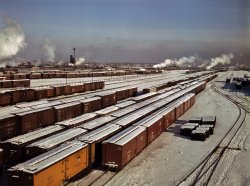
- Turkey Special: 1922
- ... View full size.
Jitters OUCH - all the way from Chicago to DC with snow chains on a stiff suspension - Needless to say that ... DC in 1922 to necessitate chains on the wheels?
Chicago Turkey Other Shorpy photos of Presidential Turkey Delivery at ... Posted by Dave - 11/21/2012 - 10:51am -
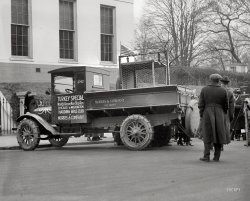
- Showtime in Chicago: 1941
- ... 1941. "The movies are popular in the Negro section of Chicago. Regal Theater and Savoy Ballroom in the Southside neighborhood." ... the same in 1961 when I was producing a series of Chicago jazz sessions for Riverside Records. I took this photo then—notice ... Posted by Dave - 02/11/2019 - 4:09pm -
![Showtime in Chicago: 1941 April 1941. "The movies are popular in the Negro section of Chicago. Regal Theater and Savoy Ballroom in the Southside neighborhood." Medium format negative by Russell Lee for the Farm Security Administration. View full size.
Looked the same in 1961when I was producing a series of Chicago jazz sessions for Riverside Records. I took this photo then—notice Sam Cooke and The Drifters were on the bill.
This ain't a rehearsalI know it's been said before, but I love the way people used to dress up to go out. I still dress up when I go out. You live one time; dressing up is a nod to the uniqueness of every day.
[As well as, in this case, Easter Sunday. - Dave]
All the more reason to resurrect the custom of dressing up to go out.
The first car is a 1940 Mercury. I bought one in 1968, and restored it by 1972. I used it for about 40 years, and then gifted it to a young friend who will take care of it for many years to come.
UneditedI find it sorta remarkable that on the coming attractions, the Regal found it necessary to say they’re showing GWTW with “Nothing Cut but the Price”. What, they were going to clip out the burning of Atlanta because the show ran long?? Oy gevalt!
Late ArrivalsI hope these filmgoers got a break at the box office in April of 1941. Both "The Philadelphia Story" and "Life With Henry" were released and had already been shown in movie houses in 1940.
Previously on Shorpy ...We've been to the Savoy for roller skating a couple of times.
The Coasters: 1941
Saturday Night: 1941
I hear a MeadowlarkIn addition to movies and roller skating, the Savoy also had basketball exhibitions by the Savoy Big Five, who later changed their name to the Harlem Globetrotters.
Basie at the SavoyIt looks as if Count Basie was playing the Savoy ... can you imagine?
ObservantI'm fascinated that the ones who noticed Mr. Lee are all children. So many of them are looking directly at the camera.
Also, The Philadelphia Story is worthy of many, many viewings.
(The Gallery, Cars, Trucks, Buses, Chicago, Movies, Russell Lee)](https://www.shorpy.com/files/images/SHORPY-8c00898a.thumbnail.jpg)
- Vacation Wagon: 1964
- ... highways, no air conditioner, 4½ hours to get through Chicago and the kids loved it. Took these trips out west to the 1970s. We still ... piece of equipment from South Texas to a parking lot near Chicago, where we would deliver it to his customer from Wisconsin. We quickly ... Posted by Dave - 05/31/2022 - 1:09am -
![Vacation Wagon: 1964 Our annual salute to the start of vacation road-trip season, first posted here 15 years ago. Everyone buckled in? Let's go!
"Great Falls, Montana. Return after 3 weeks Vacation. June 27, 1964." This Kodachrome of a 1960 Chevrolet Parkwood station wagon is from a box of slides found on eBay. View full size.
family trips in those carsI also spent some hot days in a car like that on the way to the grandparents. My mother flattened the second seat, put a mattress on the floor and loaded three of us and the stuff in on top of it, us and the stuff equally loose and not tied down. We whined and fought and slept our way to Cape Cod from southern NJ. My father always "had to work" (they were her parents), so she did the drive alone, I think maybe 12 or 16 hours? Seemed like forever.
NostalgicThese people still had a bright future ahead of them, full of great hopes for the days to come. They hadn't gone to the Moon yet, and to them, by 2007 we'd have personal helicopters and robots would run everything. The possibility of the President being indicted for a crime was unthinkable. My job as a web designer hadn't even been invented yet.
The lawn looks like it's literally astroturf. Were the colors really like that, or is it an effect of the kodachrome?
Holy cow! We had a 59 chevyHoly cow! We had a 59 chevy stationwagon back in the day. Does this bring back memories. We would drive to Florida from Virginia a two day trip usually in the heat of the summer to visit grandparents. Five children two parents no ac. Damn!
[This is a 1960 Chevrolet. - Dave]
DeflectorsDoes anybody know/remember what the deflectors left and right of the rear window were for? These may have been an aftermarket item.
It is amazing how well the colors in this slide are preserved after almost 50 years. It looks like Kodachrome all right, including the telltale blue cast in the shadows
The Astroturf look......to my eye, seems to come from the little flowers (or toadstools?) that are in the lawn. At the smaller image size, they look like specular reflections, making it seem like the grass is shiny.
[The white flowers are clover. - Dave]
1964As I remember it, this was less than a year after the assassination of JFK, there were race riots in the south and we (I was 14) were all starting to question attitudes towards women, blacks, hispanics, homosexuals and the culture we had grown up with. One of the more minor cultural things was the importance of your front lawn.
50 years?I was born in 1964, and trust me, it hasn't been 50 years since then, yet.... ;)
Re:DeflectorsThe deflectors on either side of the rear window were intended to blow air across the rear window to prevent snow from accumulating. A similar deflector is often fitted along the roof on station wagons from the 60s on. I think they were usually a factory or dealer option in later years, but I really don't know specifically about this model or when they might have first been used.
OK, 40 years.Sorry, I was too vexed on the year of manufacture of the car.
I remember that someone in our street had the sedan version of this Chevy. Like any 8 year old, I was fascinated by the winged tail and the panorama windshield. You didn't see many of these in Europe around 1960; everbody, including my father, was driving Volkswagen Beetles. (He later had a new Ford Mustang 1964 1/2 , with a 289 ci V8 and a four speed box, rally pack and (optional) front discs, which I found very impressive at the time. A real gas guzzler by European standards.
Family TrucksterThis is probably what Clark Griswold's dad took the family on vacation in. It's a 1960 Chevy, and I'm guessing it's a Kingswood model. The Brookwood was the more stripped down model and I think the "full dresser" was called a Nomad. This one isn't completely chromed-out and it has the small, dog-dish hubcaps so I'm thinking it's the middle of the line model.
I think the rear air deflectors also helped keep exhaust gas from entering the rear passenger compartment when the vehicle was moving with the tailgate window was lowered. Though it doesn't look like there's room for anybody in the third row of seats for this trip. With the window up they also helped keep the rear glass clear of snow and dust.
These are Parents of the Year......in my book. Can you imagine going across country now without all of the luxuries and Wendy's and portable DVD players and Nintendo and cell phones and credit cards?
These parents did it all the HARD way...and I'll bet they made a lot of memories that summer!
My jaw droppedOnce again the red stationwagon family blows me away. The color composition here is perfect.
Chevy ParkwoodThis is a 1960 Chevrolet Parkwood. Parkwoods and Kingswoods both use Bel Air trim (mid-level). The Kingswood, a nine-passenger wagon, has the third-row rear-facing seat, and two steps on the rear bumper (one on each end just outside of where the tailgate would come down). Less obvious is that all Kingswoods have power tailgate windows, an option on the other Chevrolet wagons.
I still drive a '59 ChevyI recommend owning one. In 2000 We took the ultimate road trip with mine from near the Canadian border in Washington State through the desert to Las Vegas and back up through California and Oregon. There really is nothing like seeing the U.S.A. in your Chevrolet. Cruising the Strip in Vegas was a blast. We might as well have been driving a space ship with the reactions we got. Sadly, these Chevrolets were mostly scrapped and very few survive.
60 ChevySadly, the third row seat had not been invented as of yet and the deflectors were used to deflect air into the rear of the stationwagon at slower speeds. I may not be an expert but I'm old enough to have ridden and slept in the back section of a folded down stationwagon. We didn't know about SUV's yet.
Chevy WagonChevy's Parkwood and Kingswood wagons could both be had with a third-row seat. And back then, for the record - wagons WERE the "SUVs" of the day!
[According to the 1960 Chevrolet sales brochure, only the Kingswood was available with third-row seating. The International Travelall and Chevy Suburban Carryall were two of the SUVs of the day. - Dave]
The luggage rackis something you don't see anymore. It hung on the wall of the garage when not in use. Once my dad, who was in a big hurry, didn't secure the tarp on top properly...
We played car games, like Alphabet, Road Bingo, and License Plates, read books, colored,sang songs and squabbled. You took your chances with local restaurants. We hadn't got used to entertainment on demand, so we didn't miss it.
And to Dave Faris: It's the film. I once assured my daughter that colors when I was a kid were the same as today. "The Fifties," she said, in her narrator's voice, "were an oddly-hued decade."
Slide ConversionHow does one convert slides to digital photos? Any website links or advice?
[You'd use a film scanner. I used a Nikon 4000 ED for this one. - Dave]
Family TrucksterWe had a green Ford station wagon, not nearly as nice as this, and with our family of six, it was a masochistic experience to take family vacations. Every summer we said that's it, we will never do this again, until the following summer when we did it again. The best part was arriving home again, but I will say that NOT having DVD's and high tech electronic gadgets forced the kids to look out the window and they gained incredible geographic knowledge from seeing the U.S. I could truthfully call these annual trips "purgatory on wheels."
Road TripMost all of my long-distance car trips were connected with moving as my father was in the USAF. In August 1954, after being in the UK 2½ years, we got in our in our '53 Chevy coupe and went from New York City to the SF Bay Area, mostly along US 40. Entertainment consisted of looking at the scenery and checking off the towns on the free roadmaps that the service stations provided in each state. Iy being the pre-Interstate era, one did go thru many towns back then! (Excepting on the PA Turnpike) Burma-Shave signs relieved the boredom in the rural areas. We had a car radio (AM only, of course), but for some reason I can only recall it being used while crossing the salt flats west of Salt Lake City.
Westward HoIn 1951 our family, my wife, son and daughter, living in Detroit, started taking trips to Cheney, Washington, to visit my WW2 buddy. All on old state highways, no air conditioner, 4½ hours to get through Chicago and the kids loved it. Took these trips out west to the 1970s. We still go west to see my buddy and my daughter in Seattle and we enjoy crossing Nebraska on old U.S. 30. It is a treat to be off of I-80.
Nostalgia Ain't What it Used to BeDon't look at this picture and pine for the old days.
Change the car to a green Olds Vista Cruiser and that's us in 1969. Back then, dads bought a new station wagon to kick off the summer vacation. Dads don't buy an SUV today for that reason.
Without repeating some of the horrors already mentioned below, there was the additional joy of Mom sending back a Coca Cola bottle for one of her sons to use in lieu of a loo. If the girls had to go, we had to pull over. Not so with the boys.
Watching mom backhand-fling a Coke bottle out her window, filled with fluid far different that what was originally intended, and seeing it bounce and spill along the shoulder as we whizzed along at 75 mph (pun intended), that's about the fondest vacation memory at least from the car perspective.
Today with the daughter hooked up to a video iPod and the sons enjoying their PSP, it's a pleasure to drive for distances. Back then, we didn't play License Plates. We played Punch Buggy and Slug Bug, etc. Fistfight games.
Let's go!I loved car trips, and I never had DVD players and Nintendo. I watched the scenery and kept a travel diary. those were some of the greatest times of my life.
Road TrripWe had to make do with pillows & blankets. A mattress would have made it actually comfortable. I don't know if Dad didn't have the imagination for that, or just not the money. I suspect the latter.
We'd sing sometimes. It was 12 hours from north Georgia near the North Carolina line to south Georgia, near the Florida line, where my grandmother lived.
I see the moon; the moon sees me.
The moon sees the one that I want to see ...
Thanks for the memoriesMy folks had the four-door sedan version of this car, in sky blue & white. My mom used to have a station wagon, don't remember what kind, but it was memorable for its pushbutton transmission on the dash instead of a gearshift! However my favorite "finned" car was our family's Buick Invicta. Now that was a car!
Third Row SeatsFords had third-row seats in 1955. I'm pretty sure Chevy had them by 1958 at least. Chevy didn't offer woodgrain sides until '65.
Sunday ridesWe had that same car, only in light blue.
No seat belts or infant seats for us! We'd put my baby sister in one of those deathtrap baby seats that hooked over the front seat and off we went!
What a picture!This picture takes me back almost 40 years to the road trips our family did during summer holidays when I was a little boy. It feels like I myself am stretching my legs after coming home. The colours, the moment -- one of my favorite pictures in Shorpy.
My Favorite Car was a 1960 Chevrolet Impala 2-dr hardtop. Bluish gray with white segment on the side, red and white interior. The first car my wife and I bought. Paid $1750 for it used in 1962. We made some wonderful trips in that car.
Re: Family TrucksterJust saw this item on TV yesterday about a real family named Griswold that had their station wagon modded to look like the Family Truckster from National Lampoon's Vacation movie for their trip to Disney World.
http://tinyurl.com/plo5kub
See the USA in Your ChevroletFor our family, it was a 1962 Buick Invicta wagon. Huge car designed for doing massive mileage on the interstates and that's what we did -- six or seven hundred miles a day from Indiana to the Rockies for our annual vacation.
Procedure for Accessing the Cargo AreaWe had one of these when I was a kid as well. Ours was a silver gray color. See the chrome disk on the trunk door? Upon arriving at destination, here's what you had to do:
1) Put trunk key in center slot (separate keys for ignition and trunk back then)
2) Open flap (as seen in photo)
3) Rotate flap several times till rear window is fully down
4) Reach in and grab handle to drop tailgate
Simple, huh?
Looking at old red carsmakes my elbows hurt! Seemed like some of those old single stage paints, reds in particular, had to be waxed every two weeks to keep them looking decent. The widespread adoption of clearcoat finishes in the late 80's to mid 90's freed modern kids from the dreaded frequent waxing chore, thereby giving them the leisure time to start the video gaming revolution...
As Long AsThis isn't really the "End of the Road"! That's a scary title for all the Shorpy Faithful.
3 Adults + 7 Children =1000 mile round trip to see grandma.
We kids didn't mind a bit.
Seat belts?I don't think you heard "Everybody all buckled up?" all that much in '64. I'm not sure of the exact dates, but if you had seatbelts back then, you bought them at a discount store or an auto parts store like Western Auto or J. C. Whitney, and they were lap belts only. Three point seat belts didn't come along for several more years, if I recall correctly, and it wasn't until the government mandated new cars with ignition interlocks in the 1970's that "real men" started to actually use them.
Back then, we used to spend our vacations camping, so the car was packed to the gills, including the center of the back seat. My sister and I each got little cubbyholes next to the doors, with just room enough to sit for the trip to northern Wisconsin. My dad drove a two tone green '55 Oldsmobile Delta 88. I saw a picture of that car a few months ago, and as soon as I did, I started remembering a surprising amount of detail about the car's details. It was handed down to me when I went off to college in '64.
Seat beltsbobdog19006 is correct in that seat belts were not standard equipment in 1960. However, they had been available as a dealer-installed option since the 50s. By 1966, they were standard in all Chevys, and by 1968, they were federally mandated.
I spent many a happy hour on family roadtrips in our '68 Ford wagon, nestled in the narrow gap between the second row and the rear-facing third-row seat, no seat belt, of course. Neither did my siblings in the third row.
Service StickersI remember those stickers that service stations or car dealers put on the inside edge of the driver's door when you got your car serviced. This Chevrolet has two.
Our road trip rigWe had a '76 Chevy Beauville van, a ho-hum light brown rather than red, which made up for the lack of chrome spears with its cavernous interior: two bucket seats in front for Mom and Dad, two bench seats, and a homemade plywood bed. Strangely, all that space wasn't enough to prevent sibling quarrels.
The best story of this van was the return trip of its maiden voyage, when my uncle, who owned a small niche-market manufacturing firm, talked my dad into towing a piece of equipment from South Texas to a parking lot near Chicago, where we would deliver it to his customer from Wisconsin. We quickly got used to being asked at every single hotel, gas station, and rest stop, exactly what was the three-wheeled contraption with the hydraulically-actuated vertical roller-chain conveyor with teeth.
The looks on everyone's faces when my dad told them it was a grave-digging machine: Priceless!
Curtains?Every August for years we travelled from Birmingham to Cincinnati for a week of visiting my parents' relatives. Before our last such trip in '69, we went through a black-and-white '57 Plymouth Savoy, a metallic-beige '63 Ford Country Sedan wagon (the one without wood on the sides) and a '67 Olds VistaCruiser. I'd love to have that VistaCruiser back today. Ours was burgundy red and my dad put red stripe Tiger Paw tires on it. Imagine a 442 station wagon.
As for Shorpy's '60 Chevy wagon, I only just noticed the homemade or aftermarket side curtains, with vertical stripes of brown, gold and red to compliment the bright red car.
Thanks, Dave, for showing us this photo again... and including all the original comments, too. Great to relive all the great summer vacation stories with everyone!
Re: deflectorsIn the days before the rear window wiper on a station wagon, some folks put these on and the deflected air current would help to clean off that window to a degree. Not having either, within a mile that rear hatch would be almost impossible to see through. Been there, done that and got the tee-shirt.
This does bring back memoriesWe had a similar station wagon, but it was salmon (or was it mauve, or ecru?) colored with a white top (I think). It had a 460 a/c (four windows down while traveling sixty miles per hour, some times 560 with the rear tailgate window down). I remember taking a trip from Mississippi to Six Flags over Texas on U.S. Highway 82 (two lane most of the way) in Summer, 1964. The back seats were folded down, and the four of us kids had pillows, blankets, books, and board games to pass the time. It was replaced soon after with a 1965 Ford Country Squire Wagon with a/c, and fake wood paneling on the side. Instead of a rear facing bench seat, it had two small seats on either side that faced each each other.
Memories of summer tripsWe also lived in Montana back then, and our family truckster in the 1960s was a 1963 Rambler Classic station wagon. (Yes, I suffered greatly for it among my friends.) That's what I learned to drive, and we ranged all over the western US and Canada in it.
Before that, however, we traveled in a 1949 Studebaker Land Cruiser 4-door sedan, which my dad (both inventive and frugal) had outfitted with a set of three back seats that, when covered with the mattress from our roll-away bed, filled the back seat and trunk area with a very passable sleeping unit. That's where I spent most of my time on our travels. At other times, I would climb over the front seatback into the front bench seat between my parents. That's where I was on August 5, 1962, when we were preparing to leave Crescent City, CA, and heard on the radio that Marilyn Monroe had died.
Deflector's actual purposeWas to break the "vacuum" the "wall" that was the rear of that wagon created which would suck exhaust into the car if that rear window was open even a little bit. The fresh air, the snowless/cleaner rear window were merely bonuses...
Buckle up?A 1960 Chevy wagon probably didn't have seat belts unless the owner installed them. The kids in the back were pretty much free range as long as they didn't make too much noise. Lots of people piled the stuff on the roof and put a mattress in the back for the kids.
It was a great way to go and most of us survived.
[Seat belts were optional on all 1960 Chevrolets. - Dave]
Car playgroundMy folks had a Ford wagon of that era. No seatbelts. Folks put a mattress in the back. Became our playground on long trips. We had no desire to "sit" in a seat.
Miss station wagonsI miss station wagons. I prefer them to the SUVs that replaced them.
I also miss the bold bright colors that cars use to come in.
No SquattingLooking at all the stuff already loaded, I'm surprised the back of this wagon isn't dragging on the ground. In fact it's sitting pretty level. I wonder if dad had overload springs installed?
We've had one built for you.To BillyB: Station wagon suspensions were designed with the idea that they would have to haul some combination of eight people and their luggage, so they did OK when loaded down. They *were* softer than contemporary pickup trucks, so the back end of the station wagon wouldn't bounce all over if there were only one or two people in it. Especially at the time of this photo, gas was 25 cents a gallon and would be that price forever, so the factory didn't mind spending a little extra weight on a beefier suspension.
Also, most of the really heavy luggage went on the roof rack, which was fairly close to being in the middle of the wheelbase. The back-back, behind the rear seat, tended to contain lighter things, like blankets, pillows, the picnic basket, and - as the trip progressed - bags of souvenirs. If Dad wanted to use the inside rear-view mirror, you couldn't stack stuff much higher than the seats, anyway.
Source: I rode in the back of a '79 Oldsmobile wagon every summer from '79 to '87. I think the longest trip we took in it was from Kansas City to Washington, DC and back.
WagonsWe had a 1956 Ford wagon, then '61 Mercury wagon, finally a (I think) 1964 Ford wagon.
I remember one year with the Mercury, my mom ran low on gas. We were up in the mountains in a resort town. To get to the gas station, she had to reverse up hills, turn around for the downhills, turn around again for going up the next hill. What a ride.
Another time, 1965, we were in a typhoon in the current wagon. There were eleven of us in it. Another wild ride driving on a road along the bay. Waves washing over us, my mom hugging the middle of the road (there was an island we could not get across).
Wagons were great.
The 283 V-8with its 170 gross horsepower is not going to have much highway passing reserve with all that weight. Cross-flags over the V on the tailgate would have indicated one of several 348's which would have given more than enough reserve. That car is 58 years old but properly equipped could have kept pace with most cars on the road today in equal comfort. A 58 year old car in 1960 by comparison was barely even recognizable as such it was so rudimentary by comparison to the 1960 version in its looks and capabilities. The same comparisons held true in all other realms of life comparing 1960 to 1902--homes, conveniences, dress, you name it. Virtually any of those later areas are not that significantly different from their 1960 versions.
Those deflectors... were supposed to keep dust off the back window
Nikon CoolscanI am having a problem with mine. Can you recommend a place that can repair them.
[There aren't any. Try buying them used on eBay. - Dave]
283 V8Although I agree that a 348 engine would have been a better choice for this station wagon. The 170hp 283 was the base V8 engine with just a single two barrel carburetor. The next option up was also a 283 but with a four barrel which the above wagon may have had, which would have given it a little more passing power.
Koolscan softwareDave. What software program do you use with your 4000? As it seems the program that came with it is only works for Microsoft VISTA.
[I use the NikonScan software that came with the scanner, on a Windows 10 workstation. To install the software on a modern operating system, you have to disable Driver Signature Enforcement. And it's Coolscan, with a C. - Dave]
(The Gallery, Cars, Trucks, Buses, Kodachromes 1, Travel & Vacation)](https://www.shorpy.com/files/images/vacation_1960s_00.thumbnail.jpg)
- WAH: 1910
- ... of the station is 5 k.w., and is in daily operation with Chicago and steamers far out on the Atlantic ." - Dave]
Magnificent! ... Posted by Dave - 06/25/2023 - 1:57pm -
![WAH: 1910 New York circa 1910. "Waldorf-Astoria Hotel, Fifth Avenue and West 34th Street." 8x10 inch dry plate glass negative, Detroit Publishing Company. View full size.
Antennas?Were those tower structures on the roof radio antennas? The Wireless Ship Act of 1910 required passenger ships leaving from US ports to be equipped with ship to shore radios beginning in 1911. Could these towers have been related to that?
["The output of the station is 5 k.w., and is in daily operation with Chicago and steamers far out on the Atlantic." - Dave]
Magnificent!A wonderful structure and outstanding photograph.
What’s there now, you ask?The hotel was torn down and replaced by a somewhat taller office building which became well known in its own right.
Very top floorsAlways curious what it would be like to have walked around and explored the very tops floors in buildings like this. Private residences, offices, mechanical gear, secret passages, or faux spaces?
WAH not there nowThis address is the future site of a much bigger building, the Empire State Building, which opened in 1931.
Empire Suite I would have loved to have stayed there in a lavish suite.
And here I was ...... thinking "WAH" was the sound Caroline Astor (the "Mrs. Astor") made when her nephew started construction on the Waldorf Hotel next to her brownstone mansion, the ballroom of which held 400 people, hence the New York 400.
More on the feud: here
Wah WahHad it burned (like other Shorpy hotels), I wonder if wah wah would have saved the WAH.
Architecture... has devolved immensely.
(The Gallery, DPC, NYC, Streetcars)](https://www.shorpy.com/files/images/SHORPY-4a55227a.thumbnail.jpg)
- S.S. Deathtrap: 1910
- ... listing problems, rolled onto its side while docked in the Chicago River. 8x10 inch dry plate glass negative, Detroit Publishing Company. ... docked at the Clark Street Bridge, never left the Chicago River. Tragedy struck as the ship rolled over into the river at the ... Posted by Dave - 09/24/2023 - 9:40pm -
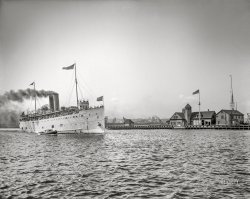
- Chicago Beach: 1900
- The Windy City circa 1900. "Chicago Beach Hotel, Hyde Park Boulevard." On the Lake Michigan Riviera. 8x10 ... as this article from the May 5, 1908 issue of The Chicago Daily Tribune attests:
Fire escape I recognized the fire ... school in 1958 or 1959, after that awful school fire in Chicago at Our Lady of the Angels. It made two on the second floor of our 1888 ... Posted by Dave - 05/25/2017 - 8:01pm -
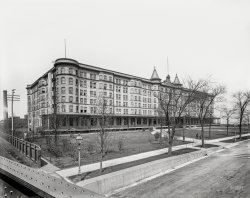
- Heart of Chicago: 1901
- Circa 1901. "The Heart of Chicago." An amazingly detailed (and smoky) tableau. 8x10 inch dry plate glass ... staircase, and it was not fire-protected. The Rookery in Chicago (Burnham and Root, 1885-1888) has a similar semicircular spiral ... have never seen anything like it before.
(The Gallery, Chicago, DPC, Streetcars) ... Posted by Dave - 07/20/2012 - 3:37pm -
![Heart of Chicago: 1901 Circa 1901. "The Heart of Chicago." An amazingly detailed (and smoky) tableau. 8x10 inch dry plate glass negative, Detroit Publishing Company. View full size.
Yes, it is a Spiral Staircase (or a Half-Spiral)That building, seen from the back, is the Hartford Building (Henry Ives Cobb, architect, 1893) at the southwest corner of Dearborn and Madison Streets. The early skyscrapers of the day usually had only one staircase, and it was not fire-protected. The Rookery in Chicago (Burnham and Root, 1885-1888) has a similar semicircular spiral staircase rising up one side of its interior light court.
Clark StreetArnheim the Tailor places this picture roughly at 155-157 South Clark Street.
You can also see the original version of the Morrison Hotel, which eventually was expanded to 40 stories. The building was razed in 1965 and is now the site of the First National Bank.
Fantastic View!The street running along the left side of the picture is Clark Street, looking north from approximately Monroe Street (Madison Street is the cross street with the blurry cable car train whizzing by). The notable tall buildings visible include: the Ashland Block (at the far left), the Schiller Building (to the right of the Ashland Block and partially obscured), the Unity Building (behind the "Boyce Building"), the Masonic Temple (the tallest one in sight) and the first Champlain Building (at the far right, next to the smaller building marked "Boston Store"). Needless to say, all of these have been demolished; the Champlain was the first to go - in 1916 - for the expansion of the Boston Store.
The Boston StoreSeems a little misplaced. Otherwise, I think the Boyce Building is still there.
If yer feeling ambitiousFor anyone wishing to re-create this view today, the photographer's vantage was the current site of Harris Bank at 111 West Monroe.
Do we still need Kodak?For the photogs who visit this site: are there digital cameras capable of capturing this scene, or do we still need large format cameras?
[A large- or medium-format digital camera would be more than up to the task. - Dave]
Too darn hotWith the obvious lack of AC units on the roofs, it's plain to see why so many windows were open. Offices with a window must have gone for a premium. Try to imagine the people in the inner offices trying to work wearing the heavy clothing of the time. "Of course you can use my fan, Myrtle."
[Inner offices in large buildings would have windows opening on an air shaft - Dave]
The JungleI can imagine Jurgis Rudkus walking aimlessly through these streets.
What is it?Does anyone have any idea what the part of the building is that has spiraling windows just to the left of the three awnings in the right third of the photo? I'd guess it houses a spiral staircase, but have never seen anything like it before.
(The Gallery, Chicago, DPC, Streetcars)](https://www.shorpy.com/files/images/4a07949a.thumbnail.jpg)























